EXPLORING THE LATIN QUARTER, THE OLDEST ARRONDISSEMENT IN PARIS – PART 2
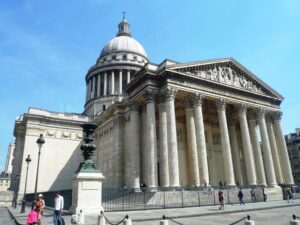
As we’ve seen from our Part One exploration of the Latin Quarter, there’s enough to keep anyone occupied for many days, as well as taking time to simply sit and enjoy people-watching, and the atmosphere of the area in a local café. This Quartier also offers a wide selection of accommodation, as well as excellent public transport to take you anywhere across Paris, and beyond. We left our scrutiny of this fascinating neighbourhood at the Curie Museum, from where we can continue on our way.
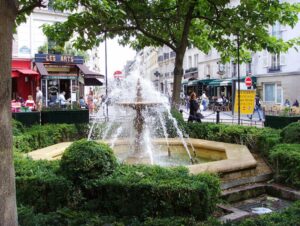
From the gentle slopes of Montagne Sainte-Geneviève, spreading out from around the Pantheon, we head to the area around the rue Mouffetard, just a few minutes away. We can sit for a while and enjoy a drink on a terrace of one the numerous cafés surrounding Place de la Contrescarpe, with its circular fountain at the centre. This is a very popular meeting place for the entire neighbourhood, and at any hour of the day, every café is busy. From here, we stroll down the picturesque, cobbled rue Mouffetard, passing yet more cafes, one of the best ice-cream parlours in Paris, Gelateria Alberto, small boutiques, souvenir shops, and a very good bookshop, ‘L’Arbre du Voyageur’ (The Traveller’s Tree), on the corner of rue Ortolan. On the adjacent corner you will see a small water well dating from 1624, that still has a trickle of water spilling forth.
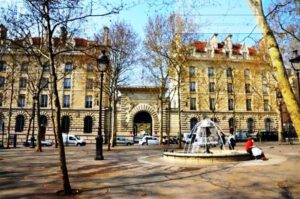
On the opposite corner to the bookshop is a huge stone building, the Garde Republicaine. This barracks of the Republican Guard was built in 1830 on the site of the convent of the Hospitalier Nuns of Our Lady of Mercy. We have never yet seen the huge timber doors facing onto rue Mouffetard open, and only occasionally the doors opening onto Place Monge. The most prominent Garde Republicaine facility is over on the Right Bank on Bvd Henri IV in the 4th arr. This too is on the site of a former convent, and houses a cavalry regiment, which is used for public security and official ceremonial events.
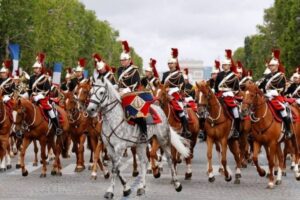
We’ve been thrilled to sometimes watch this regiment, wearing their finest dress uniforms, with the magnificent horses in their finest equipage, heading off to or returning from some official Presidential occasion.
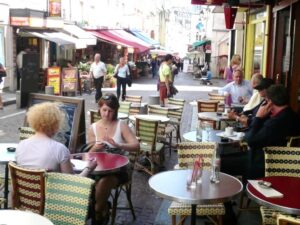
The rue Mouffetard pre-dates the Romans, and along with rue St Jacques, are regarded by historians as the oldest streets in Paris. Rue Mouffetard has had many names, and during the Roman era, it was called “Mont Cetardus” which refers to a hill close by. “Moufet” means ‘skunk’ in French, and for hundreds of years was a popular location for animal skinners, and “mofettes” related to the word meaning ‘odours of pestilence’ referring to the dreadful smells that emitted from the process of skinning and curing. Rue Mouffetard retains its medieval character, and often feels like we’ve stepped back in time. Luckily, the street escaped being included in the redevelopment works by Baron Haussmann in the 19th century.
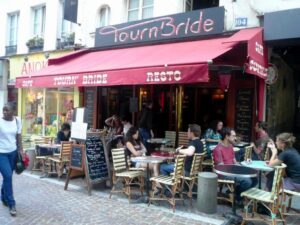
Nowadays, you will find many cafes and small bistros, some catering to a student budget, while others are well patronised by locals. We have a couple of regular favourites such as La Crete Greek restaurant, Au Petit Bistrot, run by a delightful Greek couple, and Tourn’Bride at no. 104, which is rather like a French version of a small, local pub, with excellent food at very reasonable prices, and where you’ll see many locals hanging out at any time of the day.
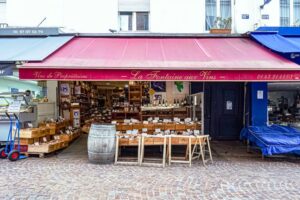
There are also any number of fresh food retailers, a couple of patisseries, specialty cheese shops, and some wonderful hand-made chocolate shops, including one recent arrival, that of the famous chef Alain Ducasse. There are 3 first rate wine shops—our favourite being La Fontaine aux Vins at no. 107, and a couple of small boutiques.
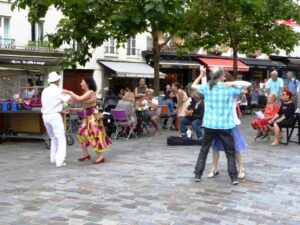
At the end of the street is a lovely little 15th century medieval church, Église Saint Medard, that has a paved area in front of it where every Sunday morning, a small group of local musicians play traditional French songs, including, of course, the Edith Piaf repertoire. Locals dance with each other, and the small crowd gathered to watch are offered song sheets to sing along with the singer. Very convivial, and something set up for and by locals, not a touristy thing at all. We love it!
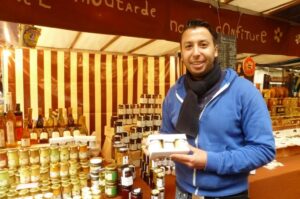
At the rear of rue Mouffetard is Place Monge, a pretty little square with shady trees, where one of the best outdoor markets in Paris takes place 3 mornings a week: Wednesdays, Fridays and Sundays. The Sunday market in particular sees people from all over the city come to shop. It’s mostly fresh food, but there are flower stalls and other vendors, including Tarik, a young Moroccan man with delicious, flavoured mustards, and Salaria, our Indian friend, whose pashminas and scarves we cannot resist. They have known us for years, and we always enjoy a chat and a catch-up with them.
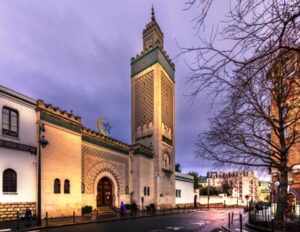
From here, I suggest you take a walk towards the nearby Jardin des Plantes, but before you reach there, looming towards you, you will see a 33m high cream minaret. This is La Grande Mosquée de Paris (the Great Mosque of Paris) on rue de Quatrefages where it meets rue Georges Desplas. This beautiful Art Deco Mosque was built by the French government after WW1 as a thank you to the North African (former) colonies of Algeria, Morocco and Tunisia who fought for France during the war and during WW2, the mosque hid nearly 2,000, mostly Jewish, Resistance fighters. As well as a vibrant place of worship, it is now an historic monument.
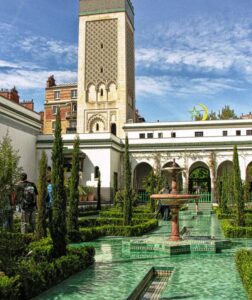
Visitors are welcome to enter, and you’ll see a beautiful courtyard garden, typical of those of the Middle East, especially those former French colonies of North Africa.
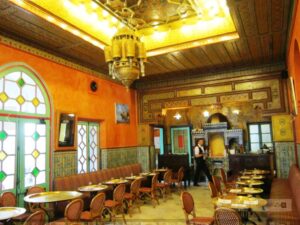
Around the corner on rue Daubenton there is a delightful café/restaurant called ‘Aux Portes de l’Orient’ (At the Doors of the East) set in a pretty garden, where we like to go for lunch on a Sunday. Great food, with typical middle-eastern treats such as tajines and couscous, as well as pastries to die for! The décor features the beautiful tile-work typical of Morocco and Tunisia, and it’s the next best thing to a visit to those countries. Very popular with locals, and indeed, it was a local friend who told us about it some years ago.
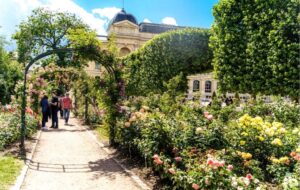
Across the road from the mosque’s café on rue Geoffroy-Saint-Hilaire is one of the entrances into the Jardin des Plantes. This is the botanic gardens of Paris that covers around 24 hectares, with numerous greenhouses that create the biodiversity of a tropical rainforest, the flora of deserts and of New Caledonia. There is a lovely rose garden, an alpine garden, a collection of Japanese peonies and a large plant maze. The garden was established in 1635 by Louis XIII to train doctors and apothecaries. At that time, it was called the ‘Jardin Royal des Plantes Médicinales’, and open to the public as well as a place for the study of plants.
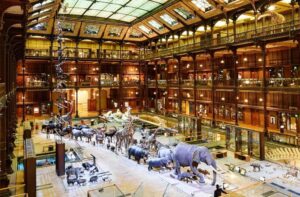
Within the Jardin des Plantes your attention will be caught be several monumental buildings of the Muséum National d’Histoire Naturelle. The Grande Galerie de l’Evolution presents the amazing history of biodiversity through 7,000 specimens of stuffed animals and skeletons under the enormous glass roof of the gallery. Normally, this type of museum isn’t something we seek out, but this one is absolutely fantastic, and we can highly recommend it, if you’re in the Jardin.
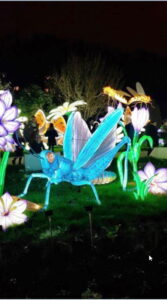
During the Christmas period, from late November to end January, the Jardin des Plantes has a wonderful show in the evenings, once the sun has gone down, called the Festival of Lights. It’s an enchanting experience for kids and adults and takes the form of a moonlit stroll through the gardens illuminated by monumental, flowering plants and giant, fantastical animals.
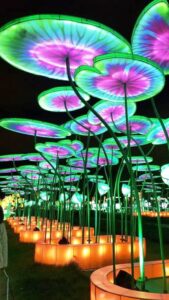
One year, the subject was endangered species, and last year’s was called The Jungle of Illumination. At the time of writing, this year’s topic hadn’t yet been announced. Pre-booking tickets is essential to gain entry. We’ve seen a couple of these shows, and they are unforgettable—a real highlight of the festive season.

The Jardin is also the site of one of the world’s oldest zoos: the Ménagerie du Jardin des Plantes, created in 1794. The zoo is home to 150 species of animals, a third of which are threatened with extinction. See around 600 animals in a green setting, including an adorable red panda hidden in a bamboo forest, Nénette the orangutan—the star of the menagerie—and snow panthers with their magnificent fur. The Ménagerie participates in breeding programs and the reintroduction into the wild of endangered species such as the Arabian Oryx and the Goden Lion Tamarin.
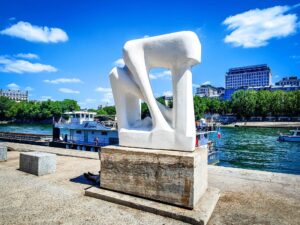
On leaving the Jardin des Plantes via Place Valhubert, turn onto Quai Saint-Bernard until you reach the Musée de la Sculpture en Plein Air (outdoor sculpture museum) in Square Tino Rossi, between the Pont de Sully and the Pont d‘Austerlitz, which displays works by Brancusi, Cesar and Zadkine. You’ll also have a lovely view of the Ile Saint-Louis.
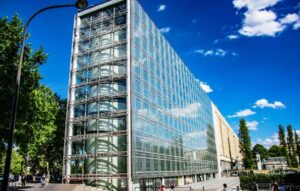
At the end of Bvd St Germain, on the corner of rue des Fosses Saint-Bernard, is one of our favourite destinations in Paris, L’Institut du Monde Arabe, (the Arab World Institute). It’s a landmark building, designed by hot-shot French architect Jean Nouvel and inaugurated in 1987 by President Mitterrand.
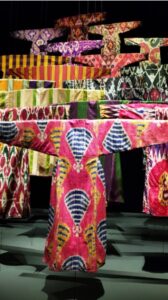
One of their most important activities are outstanding exhibitions featuring aspects of the Arab world, whether it’s artefacts, historic or cultural events. We’ve seen some of the best exhibitions in the city here, such as the history of the Orient Express train service, that actually had a couple of original train carriages in the forecourt, which you could walk through. Seats had name tags attached of famous historic travellers, such as Graham Greene, Agatha Christie, and Mata Hari.
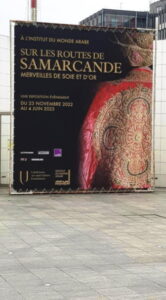
Last year’s major exhibition was about the Silk Road to Samarkand, which was stunning. This year, we saw a terrific exhibition about the history of perfume, looking at which plants are cultivated, the value to local economies with the export of products, the importance in religious practices of scents, including incense. Fascinating. We always check out the Institute’s website before we leave home.
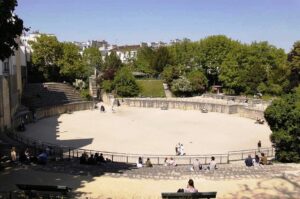
Paris also has its very own Roman arena, the Arènes de Lutèce, located at 49 rue Monge. This ancient theatre was constructed in the 1st century CE, and could once seat 15,000 people, and was also used as an amphitheatre to show gladiatorial combats. It’s regarded as among the most important ancient Roman remains in Paris. You can still see significant remnants of the stage and its nine niches, as well as the grilled cages in the wall. The stepped terraces are not original, but historians believe that 41 arched openings once punctuated the façade. When the city was sacked during the barbarian raids of 275 CE, some of the structure’s stone work was used to reinforce the city’s defences around the Ile de la Cité. Lead by Victor Hugo and a few other intellectuals, a preservation committee called La Société des Amis des Arènes undertook to save the archaeological treasure. The site is freely accessible, so don’t hesitate to take a look.
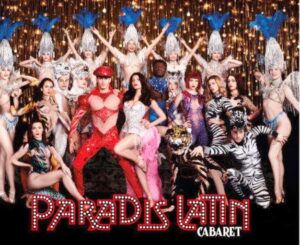
As a change of scene from history, culture and a little shopping, it comes as something of a surprise to learn that the Latin Quarter is home to the oldest cabaret in Paris, just 500m from Notre Dame. Paradis Latin, at 28 rue du Cardinal Lemoine, dates from 1889, although its history goes back to the beginning of the 19th century, during the reign of Napoleon. The place was first and foremost a theatre where bourgeois, intellectuals, merchants, workers and students met. You could also come across Balzac, Alexandre Dumas and Prosper Mérimée there, but it was not until Gustave Eiffel that the Paradis Latin became an essential place of fascination and nocturnal distractions. Today it is hard to imagine Paris without Paradis Latin with its legendary Parisian cabaret, whose festive and burlesque shows have endured through the ages.
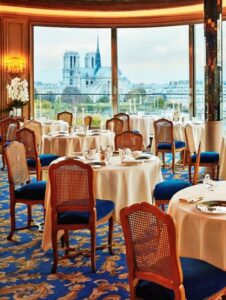
A little further along rue du Cardinal Lemoine, on the corner of Quai de la Tournelle, is one of the most famous restaurants in Paris, Le Tour d’Argent. Said to have the largest private wine cellar in Europe, it’s famous for its numerous duck dishes. As a reminder of this, little crystal ducks decorate each table, and these are available for purchase in the restaurant’s gift shop. Haute cuisine at its finest, and some say, most extravagant, it’s a favourite with the top echelons of Parisian society, and the international glitterati, although its atmosphere is discreet elegance rather than flashy. Make sure you have plenty of space available on your credit card, if you wish to dine there. Very elegant décor, and wear your Sunday best.
There are so many attractions to explore in the Latin Quarter, but simply strolling the streets, soaking up the history, the atmosphere and surprises of this ancient part of the city, is one of the joys of a visit to the City of Light.
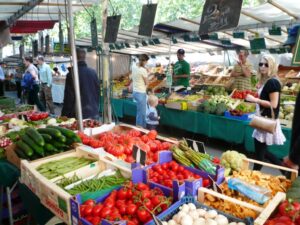


Loved this one too, Cheryl. Enjoyed staying at rue Mouffetard, was great and the arena a real find. We were there when a boules tournament was taking place and a storm came over. Everyone was hunted out by whistle blowing wardens worried about lightning strikes!
Wonderful memories,
Fond regards, Diane
Hi Diane,
What great memories you’ve got of your Paris visit! So glad you found the Arena–I’d guess that most visitors don’t even know it exists, let alone finding it. We love spending time watching boules games throughout the country, the skills of the various players, and the mix of their ages, from quite young to the elderly–so easy to waste a very pleasant hour. How lucky for you to find a boules tournament in the heart of Paris, and what’s more, in a Roman arena! Best regards, Cheryl
Ahh, the memories of Rue Mouffetard — first day ever in Paris, buying what has turned into my favourite fountain pen in some tiny newsagency; pigging out on so much food; weaving my way across to L’Institut du Monde Arabe, and then turning left and my first sight of Notre Dame. Oh, and two days later in some “pub” watching the French beat England in Rugby and not understanding more than one word in ten.
Great memories indeed Anna! One of the joys of travel is drawing upon such unforgettable experiences that stay with us forever. We do much the same thing, almost involuntarily, in so many parts of Paris in particular. You will not be surprised to know that rue Mouffetard hasn’t changed much since your visit–some bistros have perhaps changed hands and there’s currently a trend away from pizza places towards sushi bars, that we fully expect to have largely disappeared by our next visit! We went to an exhibition at the Arab Institute 2 days ago, and the tremendous works on Notre Dame continues apace. As the saying goes: la plus ca change…!